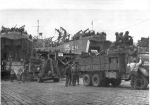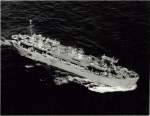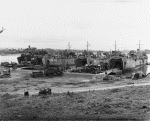US Naval History and Heritage Command
 |
261k |
USS LST-291 along with other LSTs load during the pre-invasion operations at an English port prior to the invasion of Normandy.
US Army photo |
|
 |
64k |
USS LST-291 and USS LST-510 (with LCT 517
loaded on her main deck) nested with two unidentified LSTs in May 1945 at a US port upon returning from the European theater of operations. LST-510 also brought along 140 American prisoners of war on their journey home.
LST Scuttlebutt, November/December 1992 issue (p. 45) |
Zach Morris Associate Member and Editor, LST Scuttlebutt Magazine U.S. Landing Ship Tank Association |
 |
130k |
USS LST-291 with a floating crane alongside, and USS LST-1153 beached at Thule,Greenland, circa 1948-1952. |
William D. Smith RM3 USS LST 1153 1948-1952 |
 |
106k |
USS LST-291 and USS LST-1153 beached, location unknown, circa 1948-1952. |
William D. Smith RM3 USS LST 1153 1948-1952 |
 |
128k |
USS LST-291 has her cargo removed after grounding on a submerged reef, circa 1950s. An LCM from
USS Oglethorpe (AKA-100) is alongside.
US Naval History and Heritage Command photo # NH 84846. Courtesy of William H. Davis, 1976. |
Joe Radigan MACM USN Ret. |
 |
96k |
Tugs nudge the disabled USS LST-291 into drydock at Jacksonville, FL. The vessel had 114 vehicles and 56 tons of equipment when she struck the reef.
US Navy photo from "All Hands" magazine, June 1954 |
Joe Radigan MACM USN Ret. |







